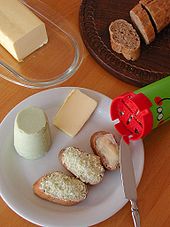Schabziger
Schabziger , also known as gravel cheese , herb cheese , green cheese , Stötzle or Sapsago (USA / Canada), is a Swiss spice-green cheese specialty from the canton of Glarus . It is made from skim milk at 90 ° C by an acid - precipitation won.
composition
100 g Schabziger contain:
- 580 kJ (137 kcal)
- 42 g dry matter
- 33 g protein
- 0.5 g fat
- <0.2 g cholesterol
- no lactose
- no carbohydrates
Additives
Lactic acid (e.g. cheese sour) is used as a processing aid. To give it flavor, table salt and Schabzigerklee ( Trigonella caerulea ) are added.
Manufacturing
The skimmed cow's milk is heated to over 90 ° C, mixed with the lactic acid culture, then the separated Ziger is left to ferment for four to twelve weeks in perforated butter or in sacks, weighted down with stones. This matured Ziger is grated, salted and stored in silos for three to eight months. Only then is powdered Schabziger clover added and the Schabziger pressed into its typical shape. After six to eight days, the "Zigerstöckli" is removed and dried on a scaffold for two to six months.
use
Schabziger is not eaten "in one piece" like most other cheeses, but mainly used grated to flavor dishes. These then appear, for example, as Zigerhörnli (pasta spiced with Ziger), Ziger fondue ( cheese fondue with Ziger addition) or Zigerbrut ( sandwich with Ziger) in cookbooks and on menus.
As products to buy there is the classic Schabzigerstöckli, from which the desired amount is scraped off with a mill or a knife, as well as cups with an Ankeziger, in which the Ziger is already mixed with butter and can thus be spread directly on bread. It is also available in grated form.
A ziger stick can be kept in the refrigerator for several weeks, while the ankeziger is best consumed within a few days. The resealable lid for the Stöckli, which is supposed to prevent it from drying out, is no longer delivered. According to the manufacturing company geska, the company has been looking for a solution for this for several years.
Historical
Ziger is said to have been made in the Glarus Alps since the 8th century. When the Glarnerland came to the Säckingen monastery in the Middle Ages , a large part of the taxes consisted of ziger, some of which was resold by the canonesses . They seasoned it with the strong-smelling black-horned clover ( Trigonella caerulea ssp. Sativa ), which the Crusaders had brought from the Orient . According to recent findings by the historian Beat Frei, the people of Zurich also played a key role in the Schabziger's success story.
By a law of the Glarner Landsgemeinde of April 24, 1463, all manufacturers in the canton of Glarus were obliged to produce the Ziger according to quality specifications and to mark it with a stamp of origin to protect it from imitation . The Glarner Schabziger is therefore the oldest branded product in Switzerland and the stamp of origin is the first traditional “ trademark ” in Switzerland.
Long after the Second World War, the so-called Zigermann (Zigermandli) sold the Schabziger directly at the front door in many places in Switzerland.
Nowadays only Geska AG produces in Glarus Schabziger.
literature
- Erika Lüscher, Beat Frei, Claudia Albisser Hund (photos): 550 years of Schabziger, recipes and stories . Fona, Lenzburg 2013, ISBN 978-3-03780-489-6 .
Web links
- Ziger in the cheese dictionary
- Geska - Society of Swiss Herbal Cheese Manufacturers, the only Schabziger manufacturer
- The stinker and his savior - report on the Ziger market and the renovation of Geska, brand eins , 10/2004
- Schabziger in the database of Swiss culinary heritage
- Schabziger Höhenweg - themed trail in the canton of Glarus with information about the Glarner Schabziger
Individual evidence
- ↑ We'll stay tuned! Resealable lid from the Stöckli. In: GESKA. May 1, 2018, accessed on February 14, 2020 (German).
- ↑ a b Glarner Schabziger - Switzerland's first branded item geska.ch


